Alexei Nikolaevich, Tsarevich of Russia
| Alexei Nikolaevich | |||||
|---|---|---|---|---|---|
| Tsesarevich of Russia | |||||
_Q81540.jpg) Tsesarevich Alexei in 1913 | |||||
| Born |
12 August 1904 Peterhof Palace, St. Petersburg Governorate, Russian Empire | ||||
| Died |
17 July 1918 (aged 13) Ipatiev House, Yekaterinburg, Russian SFSR | ||||
| |||||
| House | Holstein-Gottorp-Romanov | ||||
| Father | Nicholas II | ||||
| Mother | Alexandra Feodorovna | ||||
| Religion | Russian Orthodox | ||||
| Signature |
 | ||||
Alexei Nikolaevich (Russian: Алексе́й Никола́евич) (12 August 1904 [O.S. 30 July] – 17 July 1918) of the House of Romanov, was the Tsesarevich[note 1] and heir apparent to the throne of the Russian Empire. He was the youngest child and only son of Emperor Nicholas II and Empress Alexandra Feodorovna. He was born with hemophilia; his mother's reliance on the faith healer Grigori Rasputin to treat the disease helped bring about the end of the Romanov dynasty. After the February Revolution of 1917, he and his family were sent into internal exile in Tobolsk, Siberia. He was murdered alongside his parents, four sisters, and three retainers during the Russian Civil War by order of the Bolshevik government, though rumors that he had survived persisted until the 2007 discovery of his and one of his sisters' remains. The family was formally interred on 17 July 1998—the eightieth anniversary of the murder—and were canonized as passion bearers by the Russian Orthodox Church in 2000.
Biography
Early life

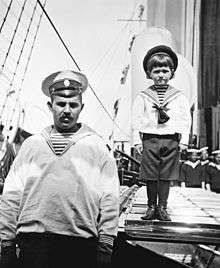
Alexei was born on 12 August [O.S. 30 July] 1904 in Peterhof Palace, St. Petersburg Governorate, Russian Empire. He was the youngest of five children and the only son born to Emperor Nicholas II and Empress Alexandra Feodorovna. His older sisters were the Grand Duchesses Olga, Tatiana, Maria and Anastasia. He was doted on by his parents and sisters and known as "Baby" in the family. He was later also affectionately referred to as Alyosha (Алёша).
Alexei was christened on 3 September 1904 in the chapel in Peterhof Palace. His principal godparents were his paternal grandmother and his great-uncle, Grand Duke Alexei Alexandrovich. His other godparents included his oldest sister, Olga; his great-grandfather King Christian IX of Denmark; King Edward VII of the United Kingdom, the Prince of Wales and William II, German Emperor. As Russia was at war with Japan, all the soldiers and officers of the Russian Army and Navy were named honorary godfathers.[3]
The christening marked the first time some of the younger members of the Imperial Family, including some of the younger sons of Grand Duke Konstantin Konstantinovich, as well as the Grand Duchesses Olga and Tatiana, and their cousin Princess Irina Alexandrovna, were present at an official ceremony. For the occasion, the boys wore miniature military uniforms, and the girls wore a smaller version of the court dress and little kokoshniks.[4] The sermon was delivered by John of Kronstadt, and the baby was carried to the font by the elderly Mistress of the Robes, Princess Maria Mikhailovna Galitzine. As a precaution, she had rubber soles put to her shoes to avoid falling and dropping him. Countess Sophie Buxhoeveden recalled:
The baby lay on a pillow of cloth of gold, slung to the Princess's shoulders by a broad gold band. He was covered with the heavy cloth-of-gold mantle, lined with ermine, worn by the heir to the crown. The mantle was supported on one side by Prince Alexander Sergeiovich Dolgorouky, the Grand Marshal of the Court, and on the other by Count [Paul] Benckendorff, as decreed by custom and wise precaution. The baby wept loudly, as might any ordinary baby, when old Father Yanishev dipped him in the font. His four small sisters, in short Court dresses, gazed open-eyed at the ceremony, Olga Nicholaevna, then nine years old, being in the important position of one of the godmothers. According to Russian custom, the Emperor and Empress were not present at the baptism, but directly after the ceremony the Emperor went to the church. Both he and the Empress always confessed to feeling very nervous on these occasions, for fear that the Princess might slip, or that Father Yanishev, who was very old, might drop the baby in the font.[5]
Hemophilia
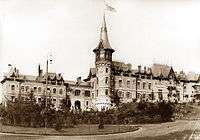
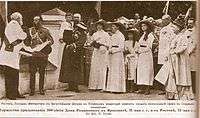
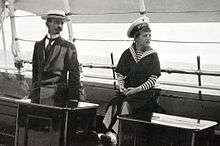

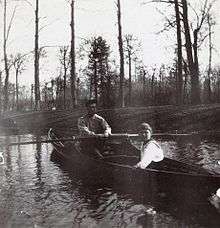
Alexei inherited hemophilia from his mother Alexandra, a condition that could be traced back to her maternal grandmother Queen Victoria. In 2009 genetic analysis determined specifically that he suffered from hemophilia B.[6][7] He had to be careful not to injure himself because he lacked factor IX, one of the proteins necessary for blood-clotting. According to his French tutor, Pierre Gilliard, the nature of his illness was kept a state secret. His hemophilia was so severe that trivial injuries such as a bruise, a nosebleed or a cut were potentially life-threatening. Two navy sailors were assigned to him to monitor and supervise him to prevent injuries, which were still unavoidable. They also carried him around when he was unable to walk. As well as being a source of constant torment to his parents, the recurring episodes of illness and long recoveries interfered greatly with Alexei's education.
In September 1912 the Romanovs were visiting their hunting retreat in the Białowieża Forest; on 5 September the careless Tsesarevich jumped into a rowboat and hit one of the oarlocks. A large bruise appeared within minutes. Within a week the hematoma reduced in size.[8] In mid September the family moved to Spała (then in Russian Poland). On 2 October, after a drive in the woods, the "juddering of the carriage had caused still healing hematoma in his upper thigh to rupture and start bleeding again."[9] Alexei had to be carried out in an almost unconscious state. His temperature rose and his heartbeat dropped, caused by a swelling in the left groin; Alexandra barely left his bedside. A constant record was kept of the boy's temperature. On 10 October, a medical bulletin appeared in the newspapers,[10] and Alexei received the last sacrament. His condition improved at once, according the Tsar. According to Nelipa Robert K. Massie was correct to recommend that psychological factors do play a part.[11] The positive trend continued throughout the next day.[12] (It is not exactly clear on which day, either 9,[13] 10 or 11 October the Tsarina turned to her lady-in-waiting and best friend, Anna Vyrubova,[14][15] to secure the help of the peasant healer, who at that time was out of favor; data are missing.) According to his daughter Rasputin received the telegram on 12 October[note 2] and the next day he responded,[17] with a short telegram, including the prophecy: "The little one will not die. Do not allow the doctors [c.q. Eugene Botkin and Vladimir Derevenko] to bother him too much."[18] On 19 October his condition was considerably better and the hematoma disappeared, but Alexei had to undergo orthopedic therapy to straighten his left leg.[19]
According to Gilliard,
The Tsar had resisted the influence of Rasputin for a long time. At the beginning he had tolerated him because he dare not weaken the Tsarina's faith in him – a faith which kept her alive. He did not like to send him away for, if Alexei Nicolaievich had died, in the eyes of the mother he would have been the murderer of his own son.[20]
There are various explanations for Rasputin's ability, such as that Rasputin hypnotized Alexei, administered herbs to him, or that his advice to the Tsarina not to let the doctors bother Alexei too much aided the boy's healing. Others speculated that, with the information he got from his confidante at the court, lady-in-waiting Anna Vyrubova, Rasputin timed his interventions for when Alexei was on the road to recovery anyway, and claimed all the credit. Court physician Botkin believed that Rasputin was a charlatan and his apparent healing powers arose from his use of hypnosis, but Rasputin was not interested in this practice before 1913 and his teacher Gerasim Papandato was expelled from St. Petersburg.[21][22] Felix Yusupov, one of Rasputin's enemies, suggested that he secretly drugged Alexei[23] with Tibetan herbs which he got from quack doctor Peter Badmayev, but these drugs were politely rejected by the court.[24][25] For Maria Rasputin, it was magnetism.[26] For Greg King, these explanations fail to take into account those times when Rasputin healed the boy, despite being 2600 km (1650 miles) away. For Fuhrmann, these ideas on hypnosis and drugs flourished because the Imperial Family lived such isolated lives.[27] (They lived almost as much apart from Russian society as if they were settlers in Canada.[27][28]) For Moynahan, "There is no evidence that Rasputin ever summoned up spirits, or felt the need to; he won his admirers through force of personality, not by tricks."[29] For Shelley, the secret of his power lay in the sense of calm, gentle strength, and shining warmth of conviction.[30] Radzinsky believed he truly possessed a supernatural healing ability or that his prayers to God saved the boy.[31]
Gilliard,[32] the French historian Hélène Carrère d'Encausse[33] and Diarmuid Jeffreys, a journalist, speculated Rasputin's healing practice included halting the administration of aspirin, a pain-relieving analgesic available since 1899.[34] Aspirin is an antiaggregant and has blood-thinning properties; it prevents clotting, and promotes bleeding which could have caused the hemarthrosis. The "wonder drug" would have worsened Alexei's joints' swelling and pain.[35][36]
Alexei and his sisters were taught to view Rasputin as "Our Friend" and to exchange confidences with him. Alexei was well aware that he might not live to adulthood. When he was ten, his older sister Olga found him lying on his back looking at the clouds and asked him what he was doing. "I like to think and wonder," Alexei replied. Olga asked him what he liked to think about. "Oh, so many things," the boy responded. "I enjoy the sun and the beauty of summer as long as I can. Who knows whether one of these days I shall not be prevented from doing it?"[37]
Childhood
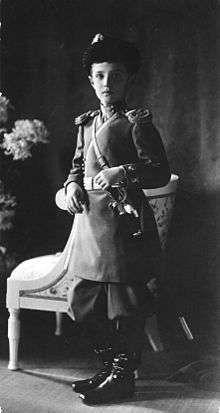
According to his French tutor, Pierre Gilliard, Alexei was a simple, affectionate child, but his environment was spoiling him by the "servile flattery" of the servants and "silly adulations" of the people around him. Once, a deputation of peasants came to bring presents to Alexei. His personal attendant the sailor Derevenko, required they kneel before Alexei. Gilliard remarked that the Tsarevich was "embarrassed and blushed violently", and when asked if he liked seeing people on their knees before him, he said, "Oh no, but Derevenko says it must be so!" When Gilliard encouraged Alexei to "stop Derevenko insisting on it", he replied that he "dare not". When Gilliard took the matter up with Derevenko, he said that Alexei was "delighted to be freed from this irksome formality".[38]
"Alexei was the center of this united family, the focus of all its hopes and affections," wrote Gilliard. "His sisters worshipped him. He was his parents' pride and joy. When he was well, the palace was transformed. Everyone and everything in it seemed bathed in sunshine."[39] He bore a striking resemblance to his mother, and was tall for his age, with "a long, finely chiseled face, delicate features, auburn hair with a coppery glint, and large grey-blue eyes like his mother,"[40] Though intelligent and affectionate, his education was frequently interrupted by bouts of haemophilia and he was spoiled because his parents couldn't bear to discipline him. His parents appointed two sailors from the Imperial Navy: Petty Officer Andrei Derevenko and his assistant Seaman Clementy Nagorny,[41] to serve as nannies and to follow him about so he would not hurt himself. He was prohibited from riding a bicycle or playing too roughly, but was naturally active.
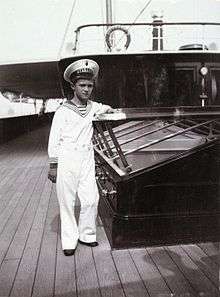
As a small child, he occasionally played pranks on guests. One example occurred at a formal dinner party, where Alexei removed the shoe of a female guest from under the table, and showed it to his father. Nicholas sternly told the boy to return the "trophy", which Alexei did after placing a large ripe strawberry into the toe of the shoe.[42]
Gilliard eventually convinced Alexei's parents that granting the boy greater autonomy would help him develop better self-control. A growing Alexei took advantage of his unaccustomed freedom, and began to outgrow some of his earlier foibles.[43] Courtiers reported that his illness made him sensitive to the hurts of others.[44] During World War I, he lived with his father at army headquarters in Mogilev for long stretches of time and observed military life.[45] Alexei became one of the first Boy Scouts in Russia.[46][47][48][49]
In December 1916, Major-General Sir John Hanbury-Williams, head of the British military at Stavka, received word of the death of his son in action with the British Expeditionary Force in France. Tsar Nicholas sent twelve-year-old Alexei to sit with the grieving father. "Papa told me to come sit with you as he thought you might feel lonely tonight," Alexei told the general.[50] Alexei, like all the Romanov men, grew up wearing sailor uniforms and playing at war from the time he was a toddler. His father began to prepare him for his future role as Tsar by inviting Alexei to sit in on long meetings with government ministers.[44]
The Tsar's Colonel Mordinov remembered Alexei:
| “ | He had what we Russians usually call "a golden heart." He easily felt an attachment to people, he liked them and tried to do his best to help them, especially when it seemed to him that someone was unjustly hurt. His love, like that of his parents, was based mainly on pity. Tsarevich Alexei Nikolaevich was an awfully lazy, but very capable boy (I think, he was lazy precisely because he was capable), he easily grasped everything, he was thoughtful and keen beyond his years ... Despite his good nature and compassion, he undoubtedly promised to possess a firm and independent character in the future.[51] | ” |
Stavka
.jpg)
During World War I, Alexei joined his father at Stavka, when his father became the Commander-in-Chief of the Russian Army. Alexei seemed to like military life very much and became very playful and energetic. In one of his father's notes to his mother, he said "…Have come in from the garden with wet sleeves and boots as Alexei sprayed us at the fountain. It is his favorite game…peals of laughter ring out. I keep an eye, in order to see that things do not go too far." Alexei even ate the soldiers' black bread and even refused when he was offered a meal that he would eat in his palace, saying "It's not what soldiers eat". In December 1915 Rasputin was invited to see Alexei when the 11-year-old boy was accidentally thrown against the window of a train, and his nose began to bleed.
In 1916, he was given the title of Lance Corporal, which he was very proud of. Alexei's favorites were the foreigners of Belgium, Britain, France, Japan, Italy, and Serbia, and in favor, adopted him as their mascot. Hanbury-Williams, whom Alexei liked, wrote " As time went on and his shyness wore off he treated us like old friends and… had always some bit fun with us. With me it was to make sure that each button on my coat was properly fastened, a habit which naturally made me take great care to have one or two unbuttoned, in which case he used to at once to stop and tell me that I was 'untidy again,' give a sigh at my lack of attention to these details and stop and carefully button me up again.”
Imprisonment of the Imperial family
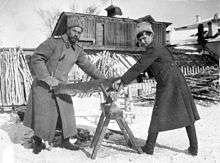
The imperial family was arrested following the February Revolution of 1917, which resulted in the abdication of Nicholas II. When he was in captivity at Tobolsk, Alexei complained in his diary about how bored he was and begged God to have mercy upon him. He was permitted to play occasionally with Kolya, the son of one of his doctors, and with a kitchen boy named Leonid Sednev. As he became older, Alexei seemed to tempt fate and injure himself on purpose. While in Siberia, he rode a sled down the stairs of the prison house and injured himself in the groin. The hemorrhage was very bad, and he was so ill that he could not be moved immediately when the Bolsheviks moved his parents and older sister Maria to Yekaterinburg in April 1918. Alexei and his three other sisters joined the rest of the family weeks later.[52] He was confined to a wheelchair for the remaining weeks of his life.
Death

The Tsarevich was less than a month shy of his fourteenth birthday when he was murdered on 17 July 1918 in the cellar room of the Ipatiev House in Yekaterinburg. The assassination was carried out by forces of the Bolshevik secret police under Yakov Yurovsky. According to one account of the murder, the family was told to get up and get dressed in the middle of the night because they were going to be moved. Nicholas II carried Alexei to the cellar room. His mother asked for chairs to be brought so that she and Alexei could sit down. When the family and their servants were settled, Yurovsky announced that they were to be executed. The firing squad first killed Nicholas, the Tsarina, and the two male servants. Alexei remained sitting in the chair, "terrified," before the assassins turned on him and shot at him repeatedly. The boy remained alive and the killers tried to stab him multiple times with bayonets. "Nothing seemed to work," wrote Yurovsky later. "Though injured, he continued to live." Unbeknownst to the killing squad, the Tsarevich's torso was protected by a shirt wrapped in precious gems that he wore beneath his tunic. Finally Yurovsky fired two shots into the boy's head, and he fell silent.[53] Rumors of Alexei's survival began to circulate when the bodies of his family and the royal servants were located. Alexei's was missing, along with that of one of his sisters (generally thought to be Maria or Anastasia). As a result of this, there have been people who have pretended to be the Tsarevich; these people are Alexei Poutziato, Joseph Veres, Heino Tammet, Michael Goleniewski and Vassili Filatov. However, scientists considered it extremely unlikely that he escaped death, due to his lifelong hemophilia. The missing bodies were said to have been cremated, though scientists believe it would have been impossible to completely cremate the bodies given the short amount of time and the materials the killing squad had to work with. Numerous searches of the forest surrounding Yekaterinburg up until 2007 failed to turn up the cremation site or the remains of Alexei and his sister.[54]
2007 remains found and 2008 identification of remains
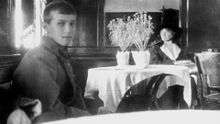
On 23 August 2007, a Russian archaeologist announced the discovery of two burned, partial skeletons at a bonfire site near Yekaterinburg that appeared to match the site described in Yurovsky's memoirs. The archaeologists said the bones are from a boy who was roughly between the ages of ten and thirteen years at the time of his death and of a young woman who was roughly between the ages of eighteen and twenty-three years old.[55] Anastasia was seventeen years, one month old at the time of the assassination, while Maria was nineteen years, one month old. Alexei was two weeks shy of his fourteenth birthday. Alexei's elder sisters Olga and Tatiana were twenty-two and twenty-one years old at the time of the assassination. Along with the remains of the two bodies, archaeologists found "shards of a container of sulfuric acid, nails, metal strips from a wooden box, and bullets of various caliber." The bones were found using metal detectors and metal rods as probes. Also, striped material was found that appeared to have been from a blue-and-white striped cloth; Alexei commonly wore a blue-and-white striped undershirt.
On 30 April 2008 Russian forensic scientists announced that DNA testing proves that the remains belong to the Tsarevich Alexei and to one of his sisters.[56]
DNA information, made public in July 2008, that has been obtained from Ekaterinburg and repeatedly tested independently by laboratories such as the University of Massachusetts Medical School reveals that the final two missing Romanov remains are indeed authentic and that the entire Romanov family housed in the Ipatiev House, Ekaterinburg were executed in the early hours of 17 July 1918.[57] In March 2009, results of the DNA testing were published, confirming that the two bodies discovered in 2007 were those of Tsarevich Alexei and one of his sisters.[58][59]
Sainthood
In 2000, Alexei and his family were canonized as passion bearers by the Russian Orthodox Church. The family had previously been canonized in 1981 by the Russian Orthodox Church Abroad as holy martyrs. The bodies of Tsar Nicholas II, Tsarina Alexandra, and three of their daughters were finally interred at St. Peter and Paul Cathedral in St. Petersburg on 17 July 1998—eighty years after they were murdered.
The reburial of Alexei's remains, so as to be with those of his family, was planned for 2015 but has been delayed due to the insistence of the Russian Orthodox Church on more DNA-testing.[60]

Historical significance
Alexei was the heir to the Romanov Throne. Paul I had passed laws forbidding women to succeed to the throne (unless there were no legitimate male dynasts left, in which case, the throne would pass to the closest female relative of the last Tsar). This was done in revenge for what he perceived to be the illegal behavior of his mother, Catherine II ("the Great") in deposing his father Peter III.
Nicholas II was forced to abdicate on 15 March [O.S. 2 March] 1917. He did this in favour of his twelve-year-old son Alexei who ascended the throne under a regency. Nicholas later decided to alter his original abdication. Whether that act had any legal validity is open to speculation. Nicholas consulted with doctors and others present and realised that he would have to be separated from Alexei. Not wanting Alexei to be parted from the family, Nicholas altered the abdication document in favour of his younger brother Grand Duke Michael Alexandrovich of Russia. After receiving advice about whether his personal security could be guaranteed, Michael declined to accept the throne without the people's approval through an election held by the proposed Constituent Assembly; no such referendum was ever held.[61]

Alexei's haemophilia was integral to the rise of Grigori Rasputin. One of the many things Rasputin did that unintentionally facilitated the fall of the Romanovs was to tell the Tsar that the war would be won once he (Tsar Nicholas II) took command of the Russian Army. Following this advice was a serious mistake as the Tsar had no military experience. The Tsarina, Empress Alexandra, a deeply religious woman, came to rely upon Rasputin and believe in his ability to help Alexei where conventional doctors had failed. This theme is explored in Robert K. Massie's Nicholas and Alexandra. It is possible that if Alexei had not suffered so terribly, Rasputin could never have gained such influence over Russian politics during World War I, which is generally seen to have at least hastened the collapse of Romanov rule.
Caring for Alexei seriously diverted the attention of his father, Nicholas II, and the rest of the Romanovs from the business of war and government.[62]
Titles, styles, honours and arms
| Styles of Tsarevich Alexei Nikolaevich of Russia | |
|---|---|
 | |
| Reference style | His Imperial Highness |
| Spoken style | Your Imperial Highness |
| Alternative style | Sir |
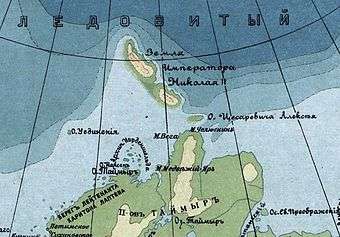
Tsarevich Alexei Island (Russian: Остров Цесаревича Алексея), later renamed Maly Taymyr, was named in honour of the Tsarevich of Russia by the 1913 Arctic Ocean Hydrographic Expedition led by Boris Vilkitsky on behalf of the Russian Hydrographic Service.[63]
Titles and styles
- 12 August 1903 - 15 March 1917: His Imperial Highness Tsarevitch Alexei Nikolaevich Romanov of Russia
- 15 March 1917 - 17 July 1918: Alexei Nikolaevich Romanov (unofficially)
- Russian
- Order of St. Andrew (12 August 1904)
- Order of St. Alexander Nevsky (12 August 1904)
- Order of the White Eagle (12 August 1904)
- Order of St. Anne, 1st class (12 August 1904)
- Order of St. Stanislaus, 1st class (12 August 1904)
- Commemorative Medal for the 100th anniversary of the Victory over France (1912)
- Commemorative Medal of the 300 years of the Romanov Dynasty (1913)
- Commemorative Medal of the 200th anniversary of the Battle of Gangut (1914)
- St. George Medal for Bravery, 4th class (1915)
- Foreign
-
_crowned.svg.png) Kingdom of Italy Order of the Most Holy Annunciation
Kingdom of Italy Order of the Most Holy Annunciation -
_crowned.svg.png) Kingdom of Italy Knight Grand Cross of the Order of Saints Maurice and Lazarus
Kingdom of Italy Knight Grand Cross of the Order of Saints Maurice and Lazarus -
_crowned.svg.png) Kingdom of Italy Knight Grand Cross of the Order of the Crown of Italy
Kingdom of Italy Knight Grand Cross of the Order of the Crown of Italy -
 Sweden Knight of the Royal Order of the Seraphim
Sweden Knight of the Royal Order of the Seraphim -
 France Grand Cross of the Legion of Honour
France Grand Cross of the Legion of Honour
Ancestry
The Royal haemophilia line
| Haemophilia in European royalty | |||||||||||||||||||||||||||||||||||||||||||||||||||||||||||||||||||||||||||||||||||||||||||||||||||||||||||||||||||||||||||||||||||||||||||||||||||||||||||||||||||||||||||||||||||||||||||||||||||||||||||||||||||||||||||||||||||||||||||||||||||||||||||||||||||||||||||||||||||||||||||||||||||||||||||||||||||||||||||||||||||||||||||||||||||||||||||||||||||||||||||||||||||||||||||||||||||||||||||||||||||||||||||||||||||||||||||||||||||||||||||||||||||||||||||||||||||||||||||||||||||||||||||||||||||||||||||||||||||||||||||||||||||||||||||||||||||||||||||||||||||||||||||||||||||||||||||||||||||||||||||||||||||||||||||||||||||||||||||||||||||||||||||||||||||||||||||||||||||||||||||||||||||||||||||||||||||||||||||||||||||||||||||||||||||||||||||||||||||||||||||||||||||||||||||||||||||||||||||||||||||||||||||||||||||||||||||||||||||||||||||||||||||||||||||||||||||||||||||||||||||||||||||||||||||||||||||||||||||||||||||||||||||||||||||||||||||||||||||||||||||||||||||||||||||||||||||||||||||||||
|---|---|---|---|---|---|---|---|---|---|---|---|---|---|---|---|---|---|---|---|---|---|---|---|---|---|---|---|---|---|---|---|---|---|---|---|---|---|---|---|---|---|---|---|---|---|---|---|---|---|---|---|---|---|---|---|---|---|---|---|---|---|---|---|---|---|---|---|---|---|---|---|---|---|---|---|---|---|---|---|---|---|---|---|---|---|---|---|---|---|---|---|---|---|---|---|---|---|---|---|---|---|---|---|---|---|---|---|---|---|---|---|---|---|---|---|---|---|---|---|---|---|---|---|---|---|---|---|---|---|---|---|---|---|---|---|---|---|---|---|---|---|---|---|---|---|---|---|---|---|---|---|---|---|---|---|---|---|---|---|---|---|---|---|---|---|---|---|---|---|---|---|---|---|---|---|---|---|---|---|---|---|---|---|---|---|---|---|---|---|---|---|---|---|---|---|---|---|---|---|---|---|---|---|---|---|---|---|---|---|---|---|---|---|---|---|---|---|---|---|---|---|---|---|---|---|---|---|---|---|---|---|---|---|---|---|---|---|---|---|---|---|---|---|---|---|---|---|---|---|---|---|---|---|---|---|---|---|---|---|---|---|---|---|---|---|---|---|---|---|---|---|---|---|---|---|---|---|---|---|---|---|---|---|---|---|---|---|---|---|---|---|---|---|---|---|---|---|---|---|---|---|---|---|---|---|---|---|---|---|---|---|---|---|---|---|---|---|---|---|---|---|---|---|---|---|---|---|---|---|---|---|---|---|---|---|---|---|---|---|---|---|---|---|---|---|---|---|---|---|---|---|---|---|---|---|---|---|---|---|---|---|---|---|---|---|---|---|---|---|---|---|---|---|---|---|---|---|---|---|---|---|---|---|---|---|---|---|---|---|---|---|---|---|---|---|---|---|---|---|---|---|---|---|---|---|---|---|---|---|---|---|---|---|---|---|---|---|---|---|---|---|---|---|---|---|---|---|---|---|---|---|---|---|---|---|---|---|---|---|---|---|---|---|---|---|---|---|---|---|---|---|---|---|---|---|---|---|---|---|---|---|---|---|---|---|---|---|---|---|---|---|---|---|---|---|---|---|---|---|---|---|---|---|---|---|---|---|---|---|---|---|---|---|---|---|---|---|---|---|---|---|---|---|---|---|---|---|---|---|---|---|---|---|---|---|---|---|---|---|---|---|---|---|---|---|---|---|---|---|---|---|---|---|---|---|---|---|---|---|---|---|---|---|---|---|---|---|---|---|---|---|---|---|---|---|---|---|---|---|---|---|---|---|---|---|---|---|---|---|---|---|---|---|---|---|---|---|---|---|---|---|---|---|---|---|---|---|---|---|---|---|---|---|---|---|---|---|---|---|---|---|---|---|---|---|---|---|---|---|---|---|---|---|---|---|---|---|---|---|---|---|---|---|---|---|---|---|---|---|---|---|---|---|---|---|---|---|---|---|---|---|---|---|---|---|---|---|---|---|---|---|---|---|---|---|---|---|---|---|---|---|---|---|---|---|---|---|---|---|---|---|---|---|---|---|---|---|---|---|---|---|---|---|---|---|---|---|---|---|---|---|---|---|---|---|---|---|---|---|---|---|---|---|---|---|---|---|---|---|---|---|---|---|---|---|---|---|---|---|---|---|---|---|---|---|---|---|---|---|---|---|---|---|---|---|---|---|---|---|---|---|---|---|---|---|---|---|---|---|---|---|---|---|---|---|---|---|---|---|---|---|---|---|---|---|---|---|---|---|---|---|---|---|---|---|---|---|---|---|---|---|---|---|---|---|---|---|---|---|---|---|---|---|---|---|---|---|---|---|---|---|---|---|---|---|---|---|---|---|---|---|---|---|---|---|---|---|---|---|---|---|---|---|---|---|---|---|---|---|---|---|---|---|---|---|---|---|---|---|---|---|---|---|---|---|---|---|---|---|---|---|---|---|---|---|---|---|---|---|---|---|---|---|---|---|---|---|---|---|---|---|---|---|---|---|---|---|---|---|---|---|---|---|---|---|---|---|---|---|---|---|---|---|---|---|---|---|---|---|---|---|---|---|---|---|---|---|---|---|---|---|---|---|---|---|---|---|---|---|---|---|---|---|---|---|---|---|---|---|---|---|---|---|---|---|---|---|---|---|---|---|---|---|---|---|---|---|---|---|---|---|---|---|---|---|---|---|---|---|---|---|---|---|---|---|---|---|---|---|---|---|---|---|---|---|---|---|---|---|---|---|---|---|---|---|---|---|---|---|---|---|---|---|---|---|---|---|---|---|
Legend: X – unaffected X chromosome; x – affected X chromosome; Y – Y chromosome | |||||||||||||||||||||||||||||||||||||||||||||||||||||||||||||||||||||||||||||||||||||||||||||||||||||||||||||||||||||||||||||||||||||||||||||||||||||||||||||||||||||||||||||||||||||||||||||||||||||||||||||||||||||||||||||||||||||||||||||||||||||||||||||||||||||||||||||||||||||||||||||||||||||||||||||||||||||||||||||||||||||||||||||||||||||||||||||||||||||||||||||||||||||||||||||||||||||||||||||||||||||||||||||||||||||||||||||||||||||||||||||||||||||||||||||||||||||||||||||||||||||||||||||||||||||||||||||||||||||||||||||||||||||||||||||||||||||||||||||||||||||||||||||||||||||||||||||||||||||||||||||||||||||||||||||||||||||||||||||||||||||||||||||||||||||||||||||||||||||||||||||||||||||||||||||||||||||||||||||||||||||||||||||||||||||||||||||||||||||||||||||||||||||||||||||||||||||||||||||||||||||||||||||||||||||||||||||||||||||||||||||||||||||||||||||||||||||||||||||||||||||||||||||||||||||||||||||||||||||||||||||||||||||||||||||||||||||||||||||||||||||||||||||||||||||||||||||||||||||||
See also
Notes
- ↑ The title tsesarevich is most often confused with tsarevich, which is a distinct word with a different meaning: Tsarevich was the title for any son of a tsar, including sons of non-Russian rulers accorded that title, e.g. Crimea, Siberia, Georgia while Tsesarevich was the title reserved for the heirs of the Emperors of Russia after Peter I.[1][2]
- ↑ If Rasputin's daughter - after eleven years - was right about the day the telegram was sent by Rasputin (October 13th) "the longstanding claim that Rasputin had somehow alleviated Alexei's condition is simply fictitious."[16]
References
- ↑ Macedonsky, Dimitry (2005–2006). "Hail, Son of Caesar! A Titular History of Romanov Scions". European Royal History Journal. Arturo E. Beeche. 8.3 (XLV): 19–27.
- ↑ Burke's Royal Families of the World II. Burke's Peerage Ltd. 1980. p. 65. ISBN 0-85011-029-7.
- ↑ Baroness Sophie Buxhoeveden, The Life and Tragedy of Alexandra Feodorovna, 1928.
- ↑ Christening of Alexei 1904
- ↑ Buxhoeveden, 1928.
- ↑ Michael Price (8 October 2009). "Case Closed: Famous Royals Suffered From Hemophilia". ScienceNOW Daily News. AAAS. Archived from the original on 12 October 2009. Retrieved 9 October 2009.
- ↑ Evgeny I. Rogaev; et al. (8 October 2009). "Genotype Analysis Identifies the Cause of the "Royal Disease"". Science. Archived from the original on 13 October 2009. Retrieved 9 October 2009.
- ↑ M. Nelipa (2015) Alexei. Russia's Last Imperial Heir: A Chronicle of Tragedy, pp. 76-77.
- ↑ Rappaport, p. 179.
- ↑ M. Nelipa (2015) ALEXEI, Russia's Last Imperial Heir: A Chronicle of Tragedy. Chapter III, p. 84.
- ↑ Robert K. Massie (1967) Nicholas and Alexandra, p. 15?
- ↑ M. Nelipa (2015) Alexei, Russia's Last Imperial Heir: A Chronicle of Tragedy. Chapter III, pp. 85-86.
- ↑ Fuhrmann, p. 101.
- ↑ Vyrubova, p. 94
- ↑ Moe, p. 156.
- ↑ M. Nelipa (2015) Alexei. Russia's Last Imperial Heir: A Chronicle of Tragedy, p. 90.
- ↑ M. Rasputin, The Real Rasputin, p. 72.
- ↑ Fuhrmann, pp. 100–101.
- ↑ M. Nelipa (2015) Alexei. Russia's Last Imperial Heir: A Chronicle of Tragedy, p. 93.
- ↑ Gilliard, Pierre (1921). Thirteen Years at the Russian Court. Translated by F. Appleby Holt (3rd ed.). London: Hutchinson & Co. pp. 177–178. Retrieved 7 June 2015.
- ↑ Pares, p. 138.
- ↑ Fuhrmann, p. 103.
- ↑ Alexanderpalace.org. Retrieved on 15 July 2014.
- ↑ "The Life and Tragedy of Alexandra – Chapter XV – A Mother's Agony – Rasputin"
- ↑ Moe, p. 152.
- ↑ Rasputin, p. 33.
- 1 2 Bernard Pares (6 January 1927) Rasputin and the Empress: Authors of the Russian Collapse. Foreign Affairs. Retrieved on 15 July 2014.
- ↑ Rappaport, p. 117.
- ↑ Moynahan, p. 165.
- ↑ G. Shelley (1925) "The Speckled Domes. Episodes of an Englishman's life in Russia", p. 60.
- ↑ Edvard Radzinsky, The Rasputin File, Doubleday, 2000, p. 77
- ↑ Le Précepteur des Romanov by Daniel GIRARDIN
- ↑ H.C. d'Encausse (1996) Nicolas II, La transition interrompue, p. 147, (Fayard) ; Holy People of the World: A Cross-cultural Encyclopedia.
- ↑ Diarmuid Jeffreys (2004). Aspirin: The Remarkable Story of a Wonder Drug. Bloomsbury Publishing.
- ↑ Aspirin: The Story of a Wonder Drug Review by Boleslav L Lichterman in BMJ (British Medical Journal) 11 Dec 2004; 329(7479): 1408.
- ↑ HEROIN® and ASPIRIN® The Connection! & The Collection! - Part II By Cecil Munsey
- ↑ Massie, p. 143
- ↑ "Pierre Gilliard – Thirteen Years at the Russian Court – memoirs of Nicholas, Alexandra and their family – Influence of Rasputin – Vyrubova – My Tutorial Troubles". alexanderpalace.org. Archived from the original on 8 October 2010. Retrieved 30 October 2010.
- ↑ Robert K. Massie, Nicholas and Alexandra, 1967, p. 137.
- ↑ Massie, p. 144
- ↑ Kurth, Peter, "Tsar: the lost world of Nicholas and Alexandra", Allen & Unwin, 1998, p. 74, ISBN 1-86448-911-1
- ↑ Massie, pp. 136–143
- ↑ Massie, p. 145
- 1 2 Massie, pp. 136–146
- ↑ Massie, p. 296
- ↑ Biography of Pantuhin on side pravoverie.ru (Russian)
- ↑ "NATIONAL ORGANISATION OF RUSSIAN SCOUTS-History and Traditions". Pine Tree Web. Archived from the original on 9 May 2008. Retrieved 16 April 2008.
- ↑ "NATIONAL ORGANISATION OF RUSSIAN SCOUTS-Who Are We ?". National Organisation of Russian Scouts (N.O.R.S.). Retrieved 16 April 2008.
- ↑ "NATIONAL ORGANISATION OF RUSSIAN SCOUTS (NORS)". NORS Australia. Retrieved 16 April 2008.
- ↑ Massie, p. 307.
- ↑ Zeepvat, Charlotte, The Camera and the Tsars: A Romanov Family Album, Sutton Publishing Limited, 2004, p. 20
- ↑ King and Wilson, pp. 83–84
- ↑ King and Wilson, pp. 309–310
- ↑ King and Wilson, pp. 458–470
- ↑ Bones found by Russian builder finally solve riddle of the missing Romanovs by Luke Harding of The Guardian (UK)
- ↑ Eckel, Mike (2008). "DNA confirms IDs of czar's children". yahoo.com. Archived from the original on 1 May 2008. Retrieved 30 April 2008.
- ↑ "DNA Confirms Remains Of Czar's Children". cbsnews.com. 30 April 2008. Retrieved 10 November 2014.
- ↑ Details on the testing of the Imperial remains are contained in Rogaev, E.I., Grigorenko, A.P., Moliaka, I.K., Faskhutdinova, G., Goltsov,A., Lahti, A., Hildebrandt, C., Kittler, E.L.W. and Morozova, I., "Genomic identification in historical case of Nicholas II Royal family.", Proceedings of the National Academy of Sciences, (2009). The mitochondrial DNA of Alexandra, Alexei, and Maria are identical and of haplogroup H1. The mitochondrial DNA of Nicholas was haplogroup T2. Their sequences are published at GenBank as FJ656214, FJ656215, FJ656216, and FJ656217.
- ↑ "DNA proves Bolsheviks killed all of Russian Czar's children", CNN (11 March 2009)
- ↑ Article in The Guardian 2015-09-11
- ↑ Kerensky, A. F. (1927), The Catastrophe, Chapter 1, Marxists Internet Archive
- ↑ Massie, Nicholas and Alexandra, 1967
- ↑ Barr, William (1975). "Severnaya Zemlya: the last major discovery". Geographical Journal. 141 (1): 59–71. doi:10.2307/1796946.
Further reading
- Greg King and Penny Wilson, The Fate of the Romanovs, John Wiley and Sons, 2003, ISBN 0-471-20768-3
- Robert K. Massie, Nicholas and Alexandra, 1967.
- Robert K. Massie, The Romanovs: The Final Chapter, Random House, 1995, ISBN 0-394-58048-6
- Andrei Maylunas and Sergei Mironenko, A Lifelong Passion: Nicholas and Alexandra: Their Own Story, Doubleday, 1997, ISBN 0-385-48673-1
- Edvard Radzinsky, The Rasputin File, Doubleday, 2000, ISBN 0-385-48909-9
- Demetrios Serfes, A Miracle Through the Prayers of Tsar Nicholas II and Tsarevich Alexis
- Maxim Shevchenko, The Glorification of the Royal Family, a 2000 article in the Nezavisimaya Gazeta
- Charlotte Zeepvat, The Camera and the Tsars: A Romanov Family Album, Sutton Publishing, 2004, ISBN 0-7509-3049-7
External links
| Wikimedia Commons has media related to Alexei Nikolaievich of Russia. |
- Alexei Romanov Fan Club
- The Romanov Memorial
- Posthumous account of Alexei's life, told in first person
- FrozenTears.org A media library of the last Imperial Family.
- The Search Foundation, an organization dedicated to searching for the remains of the two "missing" Romanov children.
- Tsarevich Alexei A Spanish site about the life of the Tsarevich Alexei.
- RoyalRussia.org: Tsarevich Alexis Heir to the Throne.